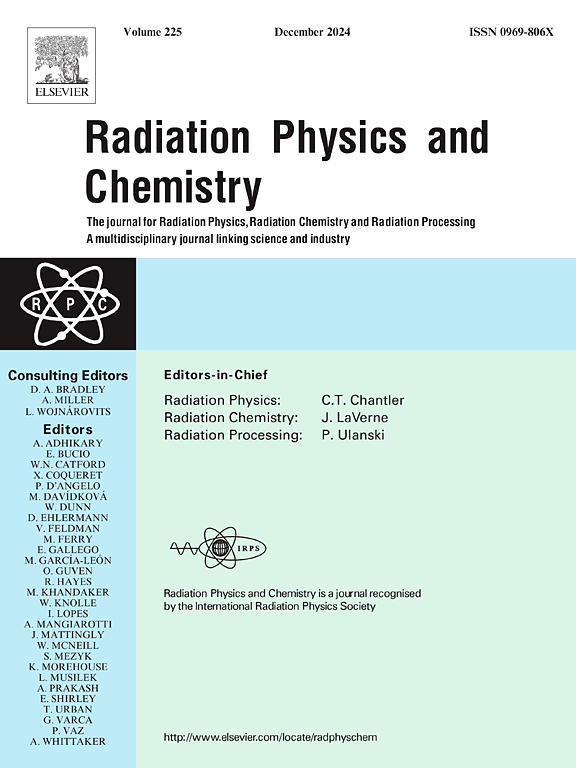Organo-functionalization of polyvinyl cyanide for sorption of 152+154Eu-citrate chelates
IF 2.8
3区 物理与天体物理
Q3 CHEMISTRY, PHYSICAL
引用次数: 0
Abstract
This study applied radiation-induced polymerization to synthesize cetrimonium bromide-functionalized polyvinyl cyanide (CBFPVC). This polymeric material was utilized as an adsorbent for 152+154Eu(III)-citrate anionic complexes from aqueous solutions. The effects of various parameters such as sample mass, equilibrium time, solution pH, and the citrate-to-Eu(III) ratio were studied under static conditions. The synthesized sorbent effectively removed the investigated Eu(III)-citrate chelates from their aqueous solutions with only few minutes needed to attain equilibrium. At [citrate]/[Eu(III)] molar ratio of 2:1, 90 % of the Eu(III)-citrate was sorbed onto CBFPVC at pH 10 in the first hour of contact. The sorption data is best with the pseudo-second-order kinetic model, indicating chemisorption. The experimental sorption equilibrium data were analyzed using a variety of isotherm models (Langmuir, Freundlich, and Dubinin-Radushkevich), and the first one exhibited the best alignment. The calculation of thermodynamic parameters (ΔG°, ΔH°, and ΔS°) indicates that the sorption process was endothermic, favorable, and spontaneous. Several desorbing agents were used to study the desorption of Eu(III)-citrate from the loaded sample and Na2SO4 solution produced the highest recovery.
聚乙烯醇对152+ 154eu -柠檬酸盐螯合物吸附的有机功能化研究。
采用辐射聚合法制备了溴化西曲铵功能化聚氯乙烯(CBFPVC)。该高分子材料被用作152+154Eu(III)-柠檬酸盐阴离子配合物的吸附剂。在静态条件下研究了样品质量、平衡时间、溶液pH、柠檬酸与eu (III)比等参数对反应的影响。合成的吸附剂可以有效地将所研究的Eu(III)-柠檬酸盐螯合物从水溶液中去除,只需几分钟即可达到平衡。当[柠檬酸盐]/[Eu(III)]摩尔比为2:1时,90%的Eu(III)-柠檬酸盐在pH为10的CBFPVC上吸附1小时。拟二级动力学模型的吸附数据最好,表明是化学吸附。采用Langmuir、Freundlich和Dubinin-Radushkevich等温线模型对实验吸附平衡数据进行了分析,结果表明,Langmuir等温线模型具有最佳的对准性。热力学参数(ΔG°,ΔH°和ΔS°)的计算表明,吸附过程是吸热的,有利的,自发的。研究了几种解吸剂对负载样品中Eu(III)-柠檬酸盐的解吸效果,以Na2SO4溶液的回收率最高。
本文章由计算机程序翻译,如有差异,请以英文原文为准。
求助全文
约1分钟内获得全文
求助全文
来源期刊

Radiation Physics and Chemistry
化学-核科学技术
CiteScore
5.60
自引率
17.20%
发文量
574
审稿时长
12 weeks
期刊介绍:
Radiation Physics and Chemistry is a multidisciplinary journal that provides a medium for publication of substantial and original papers, reviews, and short communications which focus on research and developments involving ionizing radiation in radiation physics, radiation chemistry and radiation processing.
The journal aims to publish papers with significance to an international audience, containing substantial novelty and scientific impact. The Editors reserve the rights to reject, with or without external review, papers that do not meet these criteria. This could include papers that are very similar to previous publications, only with changed target substrates, employed materials, analyzed sites and experimental methods, report results without presenting new insights and/or hypothesis testing, or do not focus on the radiation effects.
 求助内容:
求助内容: 应助结果提醒方式:
应助结果提醒方式:


